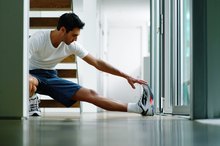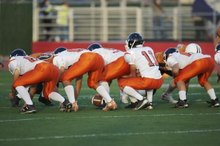Groin & Hip Pain Upon Standing & Walking
Pain in your hip and groin can indicate either a soft-tissue injury in your hip or groin or a compressed nerve. Possible soft-tissue injuries include a muscle strain, hip arthritis and hernia. Standing, walking and other activities may aggravate your symptoms. Treatments vary but often include rest, ice and physical therapy. Consult your physician for a diagnosis and treatment options.
Muscle Strain and Hernia
A strain or tear to your adductor muscles or tendons, which are located in your inner thigh and groin, can cause groin pain. Additional symptoms include hip stiffness, muscle weakness and swelling. Standing and walking may increase your pain. An adductor strain may also be called a sports hernia or athletic pubalgia, which may develop into an inguinal hernia. Inguinal hernia is when part of the small intestine protrudes through your groin muscles. Unlike inguinal hernia, sports hernia does not cause a bulge in your groin.
- A strain or tear to your adductor muscles or tendons, which are located in your inner thigh and groin, can cause groin pain.
Hip Osteoarthritis
What Causes Pain to the Back of Your Ankle & Heel When You Walk?
Learn More
Hip osteoarthritis is the wearing or degeneration of the cartilage in your hip. Along with hip and groin pain, you may experience joint stiffness, cracking or popping, and muscle loss or atrophy. Weight-bearing activities like walking may increase your symptoms and further degenerate your joint. A complication of hip osteoarthritis includes bony projections or bone spurs, which may cause more pain, "catching" in your hip and decreased hip movement.
- Hip osteoarthritis is the wearing or degeneration of the cartilage in your hip.
- A complication of hip osteoarthritis includes bony projections or bone spurs, which may cause more pain, "catching" in your hip and decreased hip movement.
Nerve Compression
Entrapment of your obturator or inguinal nerves may lead to groin or anterior hip pain. Hip or back surgery, muscle tightness, or a tumor may cause compression or entrapment of your nerves. According to a 2008 article published in “Current Reviews of Musculoskeletal Medicine," obturator nerve entrapment can be difficult to diagnose but typically occurs with an injury to your hip, groin or low back. Numbness, tingling, muscle weakness and a deep ache in your groin are additional symptoms you may experience. Standing, walking and other activities will likely aggravate your symptoms and therefore may cause you to limp.
- Entrapment of your obturator or inguinal nerves may lead to groin or anterior hip pain.
- Numbness, tingling, muscle weakness and a deep ache in your groin are additional symptoms you may experience.
Additional Causes
Difference Between Hernia & Groin Pull
Learn More
Many other conditions -- including acetabular labral tears, tendinitis, a stress fracture of your thigh bone, osteitis pubis and a bulging disc or compressed nerve in your low back -- could be additional causes of groin and hip pain. An acetabular labral tear is when the cartilage around your hip joint tears, leading to pain and joint instability. Labral tears may also increase your risk of developing osteoarthritis. Osteitis pubis is the inflammation of your pubic bone, resulting in pain that may radiate from your pubic bone into your groin and anterior hip.
- Many other conditions -- including acetabular labral tears, tendinitis, a stress fracture of your thigh bone, osteitis pubis and a bulging disc or compressed nerve in your low back -- could be additional causes of groin and hip pain.
- Osteitis pubis is the inflammation of your pubic bone, resulting in pain that may radiate from your pubic bone into your groin and anterior hip.
Treatment
Depending on the cause, the initial treatment your doctor recommends may include rest, ice, compression and elevation of your hip and leg. To further reduce pain, she may recommend that you take nonsteroidal anti-inflammatory drugs, such as ibuprofen, and use crutches when walking. She may also recommend physical therapy or surgery for severe injuries. Physical therapy helps you manage your symptoms, regain flexibility, and build hip and core strength. Consult your doctor with regard to what she recommends for your particular condition.
- Depending on the cause, the initial treatment your doctor recommends may include rest, ice, compression and elevation of your hip and leg.
Related Articles
References
- American Academy of Orthopaedic Surgeons; Sports Hernia; September 2010
- “Current Reviews of Musculoskeletal Medicine”; Obturator Neuropathy; John Sison Tipton; June 2008
- American Academy of Orthopedic Surgeons. (n.d.). Hip Fractures. https://orthoinfo.aaos.org/en/diseases--conditions/hip-fractures/
- Shetty VD, Shetty NS, Shetty AP. Groin pain in athletes: a novel diagnostic approach. SICOT J. 2015;1:16. doi:10.1051/sicotj/2015017
- Tyler TF, Silvers HJ, Gerhardt MB, Nicholas SJ. Groin injuries in sports medicine. Sports Health. 2010;2(3):231-6. doi:10.1177/1941738110366820
- Jenkins JT, O'dwyer PJ. Inguinal hernias. BMJ. 2008;336(7638):269-72. doi:10.1136/bmj.39450.428275.AD
- Chung C, Stern PJ, Dufton J. Urolithiasis presenting as right flank pain: a case report. J Can Chiropr Assoc. 2013;57(1):69-75.
- Khan AM, Mcloughlin E, Giannakas K, Hutchinson C, Andrew JG. Hip osteoarthritis: where is the pain? Ann R Coll Surg Engl. 2004;86(2):119-21. doi:10.1308/003588404322827518
- Pun S, Kumar D, Lane NE. Femoroacetabular impingement. Arthritis Rheumatol. 2015;67(1):17-27. doi:10.1002/art.38887
- Groh MM, Herrera J. A comprehensive review of hip labral tears. Curr Rev Musculoskelet Med. 2009;2(2):105-17. doi:10.1007/s12178-009-9052-9
- Moya-angeler J, Gianakos AL, Villa JC, Ni A, Lane JM. Current concepts on osteonecrosis of the femoral head.World J Orthop. 2015;6(8):590-601. doi:10.5312/wjo.v6.i8.590
- Larson CM. Sports hernia/athletic pubalgia: evaluation and management. Sports Health. 2014;6(2):139-44. doi:10.1177/1941738114523557
- Allegri M, Montella S, Salici F, et al. Mechanisms of low back pain: a guide for diagnosis and therapy. F1000Res. 2016;5. doi:10.12688/f1000research.8105.2
- Gomella P, Mufarrij P. Osteitis pubis: A rare cause of suprapubic pain. Rev Urol. 2017;19(3):156-163.
- Bisciotti GN, Auci A, Di marzo F, et al. Groin pain syndrome: an association of different pathologies and a case presentation. Muscles Ligaments Tendons J. 2015;5(3):214-22. doi:10.11138/mltj/2015.5.3.214
- American Academy of Orthopedic Surgeons. (n.d.). Hip Fractures.
- Bisciotti GN et al. Groin Pain Syndrome: An Association of Different Pathologies and a Case Presentation. Muscles Ligaments Tendons J. 2015 Jul-Sep;5(3):214-22.
- Johnson R. (2018). Approach to hip and groin pain in the athlete and active adult. Fricker P, Fields KB, eds. UpToDate. Waltham, MA: UpToDate Inc.
- Martin RR, Martin HD, Kivlan BR. Nerve Entrapment in the Hip Region: Current Concepts Review. Int J Sports Phys Ther. 2017 Dec;12(7):1163-73.
- Wilson JJ, Furukawa M. Evaluation of the Patient with Hip Pain. Am Fam Physician. 2014 Jan 1;89(1):27-34.
Writer Bio
Since 2007 Hannah Mich has written e-newsletters and been published in the "Missouri Journal of Health, Physical Education, Recreation and Dance." She has a Bachelor of Science in exercise science from Truman State University and a Master of Education in applied kinesiology from the University of Minnesota.









